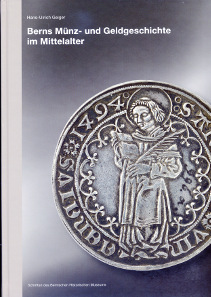by Ursula Kampmann
translated by Annika Backe
January 15, 2015 – Numismatic topics seem to have one thing in common: working on them always turns out to be much more time-consuming than expected at the beginning, when the application for the project was being submitted. Thus, Hans-Ulrich Geiger begins his foreword with describing how his project from 1991, to document the entire monetary history of Bern, slowly turned into the subject he deals with in his book published in 2014: the medieval coinage of the city of Bern until the onset of modern times, which this book dates to 1528.
Hans-Ulrich Geiger, Berns Münz- und Geldgeschichte im Mittelalter, Schriften des Bernischen Historischen Museums Band 12. Bern, Verlag Bernisches Historisches Museum, 2014. Hardcover, 30,2 x 22 cm, 245 p., 18 pl. Fig. in colour and black and white. ISBN: 978-39523269-9-2. 68 CHF.
2,100 coins have been documented for this period of time as a representative sample of the material. In addition, the records from the Bern State Archive have been used and interpreted. Hoards and coin finds are another complex of sources, with the author carefully stressing the limits of their evidential power due to the fact that tradition is always a matter of chance and the evidence of a hoard might be challenged any time by a new find.
We can only guess the date the very first coins were produced in Bern. A record, whose date – 1273 – is not beyond doubt, at least confirms that Bern had the minting privilege by that time. Until the middle of the 14th century, the German king was considered minting authority, and only in the second of the 14th century, the right to mint coins was transferred to the citizens of Bern. Both under royal and under civic control, the Bernese coat of arms was used in the minting, i.e. the bear, which is the most important feature of the coinage of Bern from around 1225 onwards.
The history of this coinage is thoroughly explained to the reader by the author in the first chapters of his book, by means of archive material. In doing so, the writer draws an excellent picture of the practical aspects of the minting of coins and everyday payment transactions. Bern is not treated as an isolated case but put in an overall Swiss context. Geiger’s book truly is a history of coinage and currency that confronts the reader with much trickier questions that the dates of known coin types. For example, what was Bern’s position in the Confederation, in terms of monetary policy? How was the Bernese monetary system related to other important Münzstände?
The book by Ulrich Geiger proves that numismatic is considerably more than a mere chronological catalogue of coin types. The actual catalogue of types, counting 37 pages and 18 plates, is only a fraction of the total work. Anyone who does not speak German as mother tongue will appreciate the clear arrangement of the plates because, unfortunately, the catalogue itself it not that neatly arranged. Even though the layout of the text is appealing to the eye, the catalogue could do with a bit more clarity.
Yet, we certainly do not want to pick holes in a magnificent book. Everybody who has become engrossed in the history of coinage and currency of Bern – which can easily happen thanks to all the interesting details, immediately understands why the work on this topic has taken more than 20 years.
This is why we recommend Geiger’s history of the Bernese coinage and currency in the Middle Ages not just to all the people who have to catalogue coins – with Geiger as the standard reference now, but likewise to those with an interest in monetary relations during the Middle Ages. They will greatly benefit from reading this book.
You can order the book at the Historical Museum of Bern online.





